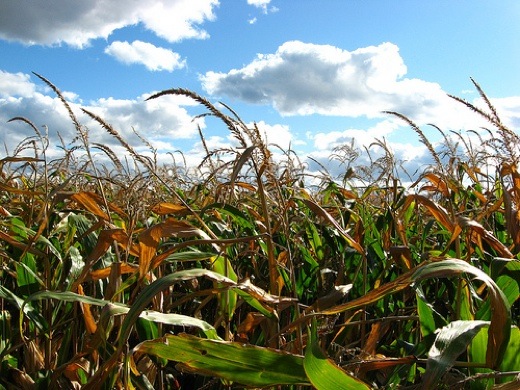 Image above: GMO corn growing in wildlife refuge. From original article.
Image above: GMO corn growing in wildlife refuge. From original article.
As part of a lawsuit settlement, the U.S. Fish & Wildlife Service announced last week it would stop (illegally) planting genetically engineered crops on all its refuges in 12 states in the northeast, according to Public Employees for Environmental Responsibility (PEER).
According to PEER, the lawsuit had charged that FWS "had illegally entered into Cooperative Farming Agreements with private parties, allowing hundreds of acres on its Bombay Hook National Wildlife Refuge in Delaware to be plowed over without the environmental review required by the National Environmental Policy Act (NEPA)."
It's not the first time that GMO crops in national refuges have sparked controversy, and although this latest lawsuit is a success for the conservation and food safety groups who filed it, additional litigation is being prepared elsewhere to address the 75 other wildlife refuges nationwide that could be growing GMO crops illegally.
From a PEER press release:
In settling the suit, the U.S. Fish & Wildlife Service promised to revoke any authorization for further GE agriculture at Bombay Hook and the four other refuges with GE crops: the Rappahannock River Valley Refuge and the Eastern Shore of Virginia Refuge, Montezuma Refuge in New York and Blackwater Refuge of Maryland, unless and until an appropriate NEPA analysis is completed - a condition that has yet to be met for GE agriculture on a National Wildlife Refuge.
"Planting genetically engineered crops on wildlife refuges is resource management malpractice," said PEER's Paula Dinerstein, who noted that FWS policy forbids "genetically modified agricultural crops in refuge management unless [they] determine their use is essential to accomplishing refuge purpose(s)."
More from PEER:
National wildlife refuges have allowed farming for decades but in recent years refuge farming has been converted to GE crops because that is only seed farmers can obtain. Today, the vast majority of crops grown on refuges are genetically engineered. Scientists warn that GE crops can lead to increased pesticide use on refuges and can harm birds, aquatic animals, and other wildlife.See also: TreeHugger: Judge rules GMOs out of Wildlife Refuges 3/27/09 ."GE crops have no place in National Wildlife Refuges," said Paige Tomaselli, Staff Attorney with the Center for Food Safety. "These pesticide-resistant crops pose significant risks to the very wildlife those refuges serve to protect, including massively increasing pesticide use and creating of pesticide-resistant superweeds. This Northeast region-wide ban is an important step in the right direction, but the Fish & Wildlife Service must stop planting these crops in other regions as well."
1 comment :
Glad to get the GMO's outta there. How in the world did they even get in?
Post a Comment